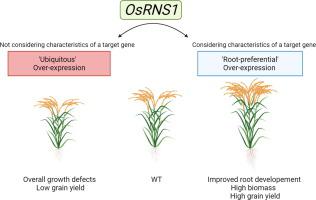Journal of Advanced Research ( IF 10.7 ) Pub Date : 2022-05-21 , DOI: 10.1016/j.jare.2022.05.007 Yun-Shil Gho 1 , Heebak Choi 1 , Sunok Moon 1 , Sung-Ryul Kim 2 , Sun-Hwa Ha 1 , Ki-Hong Jung 1

|
Introduction
Root development is a fundamental process that supports plant survival and crop productivity. One of the essential factors to consider when developing biotechnology crops is the selection of a promoter that can optimize the spatial–temporal expression of introduced genes. However, there are insufficient cases of suitable promoters in crop plants, including rice.
Objectives
This study aimed to verify the usefulness of a new rice root-preferred promoter to optimize the function of a target gene with root-preferred expression in rice.
Methods
osrns1 mutant had defects in root development based on T-DNA insertional mutant screening and CRISPR technology. To optimize the function of OsRNS1, we generated OsRNS1-overexpression plants under two different promoters: a whole-plant expression promoter and a novel root-preferred expression promoter. Root growth, yield-related agronomic traits, RNA-seq, and reactive oxygen species (ROS) accumulation were analyzed for comparison.
Results
OsRNS1 was found to be involved in root development through T-DNA insertional mutant analysis and gene editing mutant analysis. To understand the gain of function of OsRNS1, pUbi1::OsRNS1 was generated for the whole-plant expression, and both root growth defects and overall growth defects were found. To overcome this problem, a root-preferential overexpression line using Os1-CysPrxB promoter (Per) was generated and showed an increase in root length, plant height, and grain yield compared to wild-type (WT). RNA-seq analysis revealed that the response to oxidative stress-related genes was significantly up-regulated in both overexpression lines but was more obvious in pPer::OsRNS1. Furthermore, ROS levels in the roots were drastically decreased in pPer::OsRNS1 but were increased in the osrns1 mutants compared to WT.
Conclusion
The results demonstrated that the use of a root-preferred promoter effectively optimizes the function of OsRNS1 and is a useful strategy for improving root-related agronomic traits as well as ROS regulation.
中文翻译:

提高作物产量需要具有根偏好表达的 OsRNS1 的组织特异性增强
介绍
根系发育是支持植物生存和作物生产力的基本过程。开发生物技术作物时要考虑的基本因素之一是选择可以优化引入基因时空表达的启动子。然而,在包括水稻在内的农作物中没有足够的合适的启动子案例。
目标
本研究旨在验证新的水稻根偏好启动子在优化水稻根偏好表达的靶基因功能方面的有效性。
方法
基于T-DNA插入突变体筛选和CRISPR技术发现osrns1突变体存在根发育缺陷。为了优化OsRNS1的功能,我们在两个不同的启动子下生成了OsRNS1过表达植物:一个全植物表达启动子和一个新的根偏好表达启动子。分析根系生长、产量相关农艺性状、RNA-seq 和活性氧 (ROS) 积累以进行比较。
结果
通过T-DNA插入突变分析和基因编辑突变分析发现OsRNS1参与根发育。为了了解 OsRNS1 的功能增益, pUbi1 ::OsRNS1被生成用于整株植物表达,发现了根系生长缺陷和整体生长缺陷。为了克服这个问题,使用Os1-CysPrxB启动子 ( Per ) 生成了根优先过表达品系,与野生型 (WT) 相比,根长、株高和谷物产量有所增加。RNA-seq 分析表明,氧化应激相关基因的反应在两个过表达系中均显着上调,但在pPer::OsRNS1中更为明显. 此外,与 WT 相比, pPer::OsRNS1中根中的 ROS 水平显着降低,但osrns1突变体中的 ROS 水平增加。
结论
结果表明,根偏好启动子的使用有效地优化了OsRNS1的功能,是改善根系相关农艺性状和 ROS 调节的有用策略。


























 京公网安备 11010802027423号
京公网安备 11010802027423号